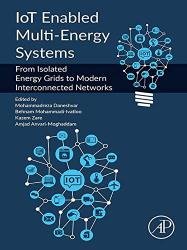IoT Enabled Multi-Energy Systems : From Isolated Energy Grids to Modern Interconnected Networks
- Добавил: literator
- Дата: 25-03-2023, 19:47
- Комментариев: 0
 Название: IoT Enabled Multi-Energy Systems : From Isolated Energy Grids to Modern Interconnected Networks
Название: IoT Enabled Multi-Energy Systems : From Isolated Energy Grids to Modern Interconnected NetworksАвтор: Mohammadreza Daneshvar, Behnam Mohammadi-Ivatloo
Издательство: Academic Press/Elsevier
Год: 2023
Страниц: 191
Язык: английский
Формат: pdf (true), epub
Размер: 10.2 MB
IoT-Enabled Multi-Energy Systems: From Isolated Energy Grids to Modern Interconnected Networks proposes practical solutions for the management and control of energy interactions throughout the interconnected energy infrastructures of the future multi-energy grid. The book discusses a panorama of modeling, planning and optimization considerations for IoT technologies, their applications across grid modernization, and the coordinated operation of multi-vector energy grids. The work is suitable for energy, power, mechanical, chemical, process and environmental engineers, and highly relevant for researchers and postgraduate students who work on energy systems.
Sections address core theoretical underpinnings, significant challenges and opportunities, how to support IoT-based developed expert systems, and how AI can empower IoT technologies to sustainably develop fully renewable modern multi-carrier energy networks. Contributors address artificial intelligence technology and its applications in developing IoT-based technologies, cloud-based intelligent energy management schemes, data science and multi-energy big data analysis, machine learning and deep learning techniques in multi-energy systems, and much more.
Reviews core applications of IoT technologies in grid modernization of multi-energy networks
Develops practical solutions for optimal integration of renewable energy resources in modern multi-vector energy networks
Analyzes the reliable integration, sustainable operation and accurate planning of multi-carrier energy grids in highly penetrated stochastic energy resources
The current book consists of nine chapters. Chapter 1 wants to provide an overview of the key role of IoT in the energy management of future modern energy networks with a high/full share of renewable energy sources. Moreover, this chapter discusses the capability of IoT technology in improving synergies among the different smart energy management devices. Chapter 2 provides an overview of multi-energy interconnected systems in different energy grids. It also elucidates the role of interconnected multi-energy systems (MESs) in a smart city as a transactive energy structure and investigates the challenges and opportunities of interconnected MESs, as well as contests of IoT-based systems components and different control approaches. Chapter 3 aims to provide an overview of the application of IoT technology in the power failure positioning service in the power system operation. It also discusses the presence of IoT in the monitoring section of cyber-physical power systems by having a look at its definition, structure, advantages, challenges, and future development opportunities. Chapter 4 describes the architecture and applications of IoT in smart grids. It also assesses the consequences of IoT in distribution networks, smart cities, microgrids, and smart buildings at the distribution level.
Chapter 5 explains the features of the energy internet as the IoT in energy grid output that are appropriate for grid performance evaluation. It also discusses IoT challenges in the smart grid along with the future research and development potentials aiming to provide a suitable overview for future trends. Chapter 6 describes data science leverage and big data’s role in IoT energy systems. It also discusses the related tools and analytics with attention to data-driven decision-making in smart energy systems. Chapter 7 presents the battery cloud that collects measured battery data from electric vehicles and energy storage systems. It also explains the applications of advanced algorithms for improving battery performance. Chapter 8 describes Federated Learning and its applications in security and privacy together with a demonstration case involving the implementation of a simulated model of Federated Learning for enhancing the security of systems. Chapter 9 aims to evaluate, develop, and test a lightweight string-matching technique suitable for a smart IoT-based virtual wireless sensor network.
Contents:
Скачать IoT Enabled Multi-Energy Systems : From Isolated Energy Grids to Modern Interconnected Networks
[related-news] [/related-news]
Внимание
Уважаемый посетитель, Вы зашли на сайт как незарегистрированный пользователь.
Мы рекомендуем Вам зарегистрироваться либо войти на сайт под своим именем.
Уважаемый посетитель, Вы зашли на сайт как незарегистрированный пользователь.
Мы рекомендуем Вам зарегистрироваться либо войти на сайт под своим именем.

